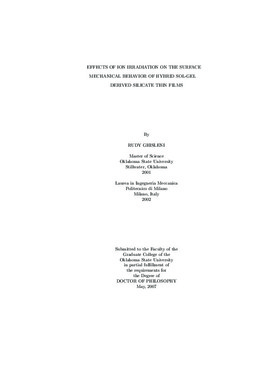| dc.contributor.advisor | Lucca, Don A. | |
| dc.contributor.author | Ghisleni, Rudy | |
| dc.date.accessioned | 2013-12-10T18:05:16Z | |
| dc.date.available | 2013-12-10T18:05:16Z | |
| dc.date.issued | 2007-05 | |
| dc.identifier.uri | https://hdl.handle.net/11244/7795 | |
| dc.description.abstract | A study on the effects of ion irradiation on the surface mechanical behavior of hybrid sol-gel derived thin films has been performed. Hybrid organic/inorganic modified silicate thin films were synthesized by sol-gel processing from tetraethoxysilane (TEOS) and methyltriethoxysilane (MTES) precursors and spin-coated onto (100) Si substrates. The synthesized films were investigated by nanoindentation, photoluminescence spectroscopy, and Raman spectroscopy. | |
| dc.description.abstract | Hybrid TEOS/MTES sol-gel films modified by ion irradiation with deposited electronic energies of 1.87 x 10^25 eV/cm 3 or higher showed higher values of reduced elastic modulus and hardness than 800�C heat treated films. Thus, ion irradiation was found to be an effective means in converting the polymer sol into ceramic type coatings. The ions used in this study were Cu^2+ , N^2+ , Si^+ , O^+ , N^+ , He^+ , and H^+ , with incident energies ranging from 100 keV to 2 MeV, and fluences ranging from 1 x 10^14 to 1 x 10^17 ions/cm 2 .Both the reduced elastic modulus and hardness were seen to increase monotonically with the increase in ion fluence, with an observed maximum hardness of 7.7 GPa (an unirradiated film hardness was 0.4 GPa) and a maximum reduced elastic modulus of 84.0 GPa (an unirradiated film reduced elastic modulus was 7.1 GPa) for 250 keV N^2+ irradiation with a 5 x 10^16 ions/cm^2 fluence. The electronic stopping power was found to be principally responsible for the film hardening, while the role of nuclear stopping power was minimal. A monotonic increase in hardness with increase in electronic energy deposited to the film surface was found. | |
| dc.description.abstract | A model describing the hardening of ion irradiated films was developed. This model characterizes the hardening effectiveness of the ion species considered by two parameters: the constant hardening cross-section and the hardening coefficient. Where the hardening cross-section represents the cross-sectional area hardened by the interaction of an incident ion with the target, and the hardening coefficient represents an index of the cross-sectional area gradient as a function of fluence. | |
| dc.description.abstract | The increase in hardness of hybrid sol-gel films following ion irradiation was linked to structural changes. Ion irradiation results in a cross-linked silica film as well as the segregation of amorphous carbon clusters, both of which contributed to increase the mechanical properties of the films. | |
| dc.format | application/pdf | |
| dc.language | en_US | |
| dc.rights | Copyright is held by the author who has granted the Oklahoma State University Library the non-exclusive right to share this material in its institutional repository. Contact Digital Library Services at lib-dls@okstate.edu or 405-744-9161 for the permission policy on the use, reproduction or distribution of this material. | |
| dc.title | Effects of ion irradiation on the surface mechanical behavior of hybrid sol-gel derived silicate thin films | |
| dc.contributor.committeeMember | Price, C. Eric | |
| dc.contributor.committeeMember | Grischkowsky, Daniel R. | |
| dc.contributor.committeeMember | Misawa, Eduardo A. | |
| osu.filename | Ghisleni_okstate_0664D_2302.pdf | |
| osu.accesstype | Open Access | |
| dc.type.genre | Dissertation | |
| dc.type.material | Text | |
| thesis.degree.discipline | Mechanical Engineering | |
| thesis.degree.grantor | Oklahoma State University | |
